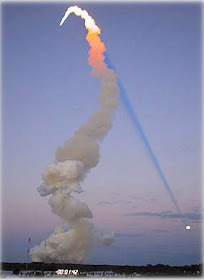
The sun has just set behind us, and it’s six degrees below the horizon. Most of the plume is in the “earth shadow,” not touched by direct sunlight. As you follow the plume upward into the higher altitudes, it catches the light of the setting sun, first red, then orange, yellow, and finally white as you go miles above the earth.
The red colors come from sunlight that has traveled through the longest stretch of the earth’s atmosphere. The color of the sun itself goes through a similar color progression as it sets. Sunlight traveling on a near tangent to the surface of the Earth has had the most blue light scattered or removed from each ray, leaving the red color.
The moon is a few hours from full, and is therefore almost 180 degrees opposite the sun at the antisolar point. The plume is casting a shadowbeam through the illuminated atmosphere. That shadow points directly toward the antisolar point. You can think of the dark line as a slice of unilluminated vapor seen edge-on. If that slice were completely unilluminated, we'd see stars through it.
It’s a good reminder that the light blue color of the sky is merely “the blue dome of the sky itself is really a semitransparent film of air interposed over the blackness of space.”
------
(These points are further explained and illustrated in Color and Light, page 176, 180, and 190).
Image from Atmospheric Optics.
Previously on GJ: Shadowbeams

This is very interesting. James, can you help me get my head around why the shadow looks so straight, but the plume looks crooked?
ReplyDeleteAlso, do you think the rocket itself adds much to the brightness of the plume? Having been to a night launch myself, it's amazing how much light a rocket can produce (the initial stage, at least)...
i love the part about the possibility of seeing stars through the shadow. awesome reference here.
ReplyDeleteRaydancer, good question. The actual shadow would be the same squiggly silhouette as the plume itself (seen from the sun's perspective). But that shape is cast laser-straight through the medium of the illuminated air. We're seeing up through a section of it. We don't see the shadowbeam where it is off-angle from our POV. The straightness of the diagonal line is by virtue of the straightness of the sun's path.
ReplyDeleteI think the bright illumination would last only for a short time immediately behind the shuttle. It might look particularly white for a while since the vapor is denser before it disperses.
Just another one of your B.Y.M. pieces of information! I'm still reeling from the coolness factor of this one.
ReplyDelete(B.Y.M.= Blow Your Mind)
I still did not get clear and short explanation on the color of setting sun. I know physics of light, dust particles in atmosphere etc, but it is still not completely clear to me. We know that the color of distant mountains appear purple/bluish because color energy is scattered as the light passes through the atmosphere, and shorter wavelenghts have greater energy than the longer ones (that is - warm colors). Therefore we see predominantly cooler colors when we look at great distances. But, the light of the sun when it is close to the horizon travels through thicker layer of atmosphere, yet its wavelentghs are not scattered the same way. We see only warm colors which have lower energy...how come?
ReplyDeleteTino, in a nutshell, anything that is bright and white, such as the sun, a white cloud, or even a white house, will get warmer as it goes back through the atmosphere. The white light, as it travels through the air, is having the shorter (bluer) wavelengths removed from it because of scattering. What's left are the yellow, orange, and warm colors. You can observe ranks of cumulus clouds getting warmer toward the horizon, too.
ReplyDeleteThis is (yet another) awesome insight into the workings of light and atmosphere. Thanks for sharing it!
ReplyDeleteOne related thing I'm playing around with is how the sky in different regions looks so different. An arizona sky is SO different than a Massachussets sky. I've not quite worked out how much is linked to the difference in humidity, and how much is psychological due to the fact that you just see so much more sky in the wide open vistas of Arizona than you do in the enveloping greens of New England.
Thanx James. I am familiar with the phenomenon. Living on Adriatic Coast I see it every day. I was just looking for physical explanation.
ReplyDeleteTo summarize - most objects get cooler as they go back through the atmosphere, unlike bright and white objects which get warmer.